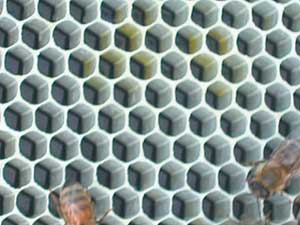
Eleven days ago, we opened the colonies for the first time since installation. It is going to rain tonight and through the weekend once more, and Colony 2 may be running out of room, so I went in again today.
Tell me I'm a brave girl, like the workers, because I opted to go in without gloves this time. It seemed better to brave stings than mash bees, since it was such a clumsy difficult session the last time, with the sugar syrup all over everything and the camera knocking about and the bees getting all upset. I could actually feel the frames, tell where the shutter button was, and handle the tools without dropping them, and no stings!
Good news first: Colony 2 is a roaring bee and honey producing monster. They have filled up all but one frame of foundation, started moving upward into the feeder, and it appears there are already new bees on the scene. When opening up their home, brace comb broke apart, full of light golden honey. I tried to put some in my mouth, but forgot there was a veil in the way. Sigh.
I brought one of the empty medium supers (the wooden thingies that hold the frames) up from the basement, and placed it carefully over the busy frames. Then I went to the feeder, cut off the brace comb that was extending down (and some that was in the middle of the feeder access) and placed it on top of the new frames. Put the feeder back on, filled it with more syrup (drink up, you greedy little piggies) and closed it up. Tried not to think about 150 dead gals. Start to really hope for maybe just a tiny honey flow for us (beekeepers, please tell me off about this!)
Worrisome news last: Colony 1 (which was actually opened first) has not made much progress in eleven days. If any beekeepers would take a look at the pictures and share opinions, I would be most grateful. Perhaps it's like this: no sooner does Queen 1 get started than the weather gets cold, her dwindling population of workers needs to spend their time bundling up, and both comb and brood production cease. But why no pollen cells, I wonder? Did I just not see them through the bees crowding what little comb there was?
No comments:
Post a Comment